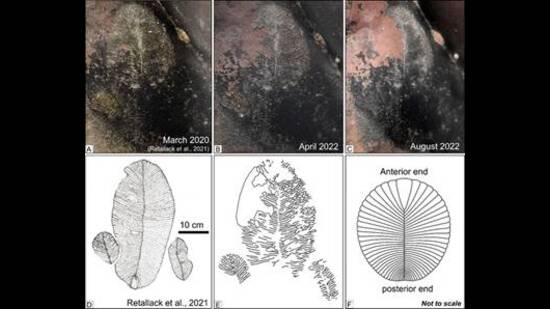Rare fossil ‘left-over impression of fallen beehive’
It has now emerged that the rare fossil isn’t really the extinct remains of the primitive animal that inhabited seabeds , but a left-over impression of a fallen beehive
Two years ago a team of palaentologists led by University of Oregon’s Gregory J Retallack, and including members from the Geological Survey of India made headlines all over the world after they claimed to have discovered the first ever Dickinsonia tenuis fossil to be discovered in India, “hiding in plain sight” in Madhya Pradesh’s Bhimbetka , renowned for its prehistoric art

It has now emerged that the rare fossil isn’t really the extinct remains of the primitive animal that inhabited seabeds , but a left-over impression of a fallen beehive.
A team of scientists from Lucknow’s Birbal Sahni Institute of Palaeosciences (BSIP), conducted a follow-up study of the rare Ediacaran fossil to take a closer look and to find similar fossils in the site. However, on closer examination of the Dickinsonia , the team found that it was the “left-over impression of a fallen beehive”, which also had traces of honey and wax, according to a statement issued by the ministry of science and technology on Friday refuting the earlier findings.
“The Vindhya basin, an archive of more than one billion years of history of the earth, is one of the largest basins of the world and is the site of many discoveries of fossil that explain how earliest life originated and diversified on the earth. Reporting of an Ediacaran fossil by a group of American scientists from the area encouraged us to take a closer look and further hunt for other similar fossils,” said SK Pandey from Birbal Sahni Institute of Palaeosciences, who led the follow-up study.
A statement issued by Pandey’s team on Friday highlighted that the purported fossil from the Maihar Sandstone of Vindhyan basin was re-examined on the field to ascertain its biogenicity—chemical and morphological signature preserved over a range of spatial scales in rocks, minerals, ice, or dust particles that are uniquely produced by past or present organisms.
Field observations, outcrop features, and detailed laboratory analyses did not support the biogenicity and syngenecity—formed at the same times as the enclosing rock—of fossil and it was inferred as a left-over impression of a fallen beehive. The study refutes the interpretation given by the original team. These findings have now been published in the Journal of Geological Society of India.
According to the government statement, in 2021, a team of palaentologists headed by Retallack claimed to have found the first ever fossil of a Dickinsonia in India on the Auditorium cave in Bhimbetka. Dickinsonia is known to be earth’s oldest animal, dating back to nearly 600 million years. That finding was published in a paper, Dickinsonia Discovered in India and Late Ediacaran Biogeography, in the journal Gondwana Research.
“The fossils are identical with Dickinsonia tenuis from the Ediacara Member of the Rawnsley Quartzite in South Australia, and like them also show deformation due to lateral impingement, arcuate pieces missing, and alignment,”that paper, published in February 2021 read.
“They are within the late Ediacaran, Maihar Sandstone of the Bhander Group, in red sandstones formed in coastal plain paleoenvironments, including eolian, tsunamite, and intertidal bedforms. This new occurrence confirms assembly of Gondwanaland by 550 Ma, but not reconstructions adjusted for true polar wander. Cloudina and other small shelly marine fossils were low latitude, but vendobionts such as Dickinsonia were at temperate to subtropical latitudes,” it added.
Countering this, the researchers from the Birbal Sahani Institute have found that unlike fossils, which are always preserved on the bedding plane of the rock strata, the sample was not entirely preserved on the bedding plane.
“Part of it was preserved on the bedding plane and part of it on transversally cut face of the Maihar Sandstone outcrop. Both fresh and decayed honey beehives were observed on the same bedding plane. A giant active beehive with several bees Apis dorsata attached to the hive was also found. Honeycomb structure was also observed. This evidence shows that the described fossil was misinterpreted as Dickinsonia,” the recent findings stated. Pandey added that such misinterpretations are rare.






